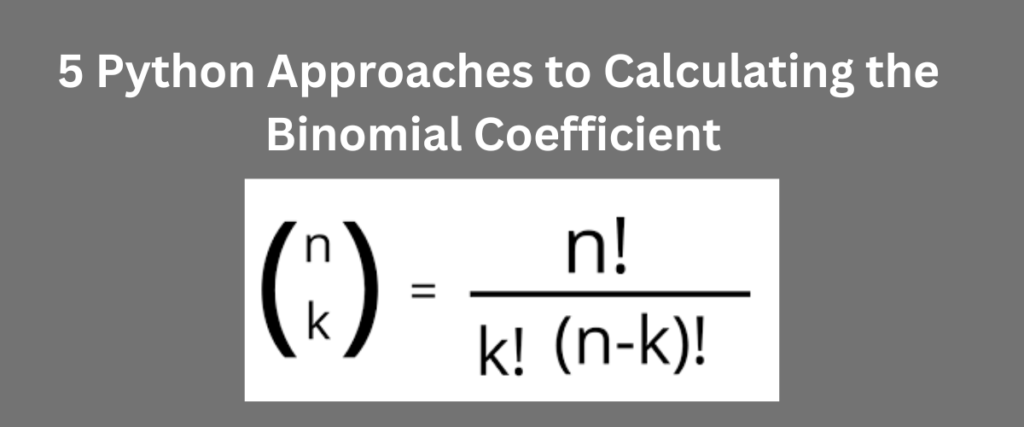Statistics and Mathematics are growing more and more crucial for understanding today’s high-end technologies such as Data Science and Machine Learning. Achieving a thorough understanding of these mathematics concepts is important to understand many complex algorithms easily.
The binomial coefficient is one such concept of mathematics that can be used in many forms like permutations and combinations.
A binomial coefficient is defined as positive integers that are the numerical coefficients of the binomial theorem.
Read on to find out about the statistics module in Python
In this post, we are going to learn more about the binomial coefficient and the Pythonic way to find the binomial coefficient of two numbers.
What Is a Binomial Coefficient?
In addition to rendering the coefficients of the binomial theorem, the binomial coefficient is also defined as the number of ways of picking k outcomes from n possibilities. Rings a bell?
This concept is similar to choosing k entities from n distinct elements, regardless of the order, which is also called a combination.
It is denoted by nCk or (n k). The formula for the binomial coefficient is given below.

Real-World Example: Calculating Binomial Coefficients
Suppose you have to find the number of possible ways to pick or choose 2 objects from a set of 5, the binomial coefficient(n = 5, k =2) can be used as follows.
We must understand the concept of factorial first to compute the binomial coefficient. Python Factorial Examples
(5 2) = 5! / 2! (5-2)!
= (5*4*3*2*1) / (2*1)(3*2*1)
= 10
We are going to try and find a Pythonic way to compute the binomial coefficient.
Computing Binomial Coefficients: Pythonic Methods
In this section, we will see five different approaches to computing the binomial coefficient of two numbers.
These are the approaches we will use.
- Simple Program
- Dynamic Programming(Memoization)
- Scipy’s binom
- Math library’s comb method
- Math library’s fact method
Basic Method: Manual Calculation
We can compute binomial coefficients using simple logic, without using any built-in functions.
def calculate_binomial_coefficient(n, k):
# Edge cases
if k < 0 or k > n:
return 0
if k == 0 or k == n:
return 1
# Ensure minimum number of iterations
k = min(k, n - k)
# Calculate binomial coefficient
result = 1
for i in range(1, k + 1):
result *= n
result //= i
n -= 1
return result
# User input
n = int(input("Enter n (total number of items): "))
k = int(input("Enter k (number of items to choose): "))
# Calculate and display result
result = calculate_binomial_coefficient(n, k)
print(f"Binomial Coefficient of {n} choose {k}: {result}")
- The function
calculate_binomial_coefficientcalculates the binomial coefficient, indicating the number of ways to choosekitems fromnitems. - Handles edge cases: returns 0 if
kis outside the range 0 ton, and returns 1 ifkis 0 or equal ton. - Utilizes symmetry in the calculation (nCk = nC(n-k)) by setting
kto the minimum ofkandn-k. - A loop calculates the coefficient directly, multiplying the result by
nand dividing by the loop counteri, while decrementingnin each iteration. - Simplifies the calculation process by avoiding separate numerator and denominator computations.
- User inputs
nandk, representing the total number of items and the number of items to choose, respectively. - The result, printed after computation, represents the number of combinations for choosing
kitems from a set ofn.

Remember the stepping condition? If the value of k is not in the range of 0 and n, this function returns 0 in such cases. In the next two lines, we are taking the input from the user and printing the result.
Optimized Approach: Using Memoization
Memoization improves efficiency by storing previously calculated values, reducing redundant calculations. This concept is an improvement over the previous approach. Instead of recursively computing the factorial of all numbers, this approach stores the factorial of previous iterations, so that the result can be used further. Now let’s write the code for demo-ing memoization.
def binc(n, k, memo={}):
if k == 0 or k == n:
return 1
if (n, k) not in memo:
memo[(n, k)] = binc(n - 1, k - 1, memo) + binc(n - 1, k, memo)
return memo[(n, k)]
result = binc(5, 2)
print(f"The binomial coefficient C({n}, {k}) is: {result}")
The main function takes three parameters – n,k, and memo. The memo is a dictionary used to store the factorial of a number so that it can be used in further processing.

Using Scipy for Binomial Coefficients
Scipy(Scientific Python) is a library that is built on top of the Numpy library to perform complex scientific computations. This library has a direct method to compute the binomial coefficient and that is scipy.special.binom.
Syntax
scipy.special.binom(x, y, out=None)
x,y are the values for which the binomial coefficient is to be computed. Additionally, the output array can also be specified.
import scipy
from scipy.special import binom
print(scipy.special.binom(5,2))

Math Library’s Factorial Method
In this method, we are going to use the math library’s factorial method to compute the binomial coefficient.
import math
def binc(n, k):
if 0 <= k <= n:
return math.factorial(n) // (math.factorial(k) * math.factorial(n - k))
else:
return 0
n = 5
k = 2
result = binc(n, k)
print(f"The binomial coefficient C({n}, {k}) is: {result}")
In this example, we just coded the formula of combination using math’s factorial method.

Efficient Calculation with Math Library’s comb Method
There is one more method in the math library that can be used to compute the binary coefficient. It is the comb() method. The comb method is used to return the combinations(nCk) without taking into consideration the order.
import math
print(math.comb(5,2))

Summary
To conclude, we have understood the roots of the binomial coefficient with the help of a numerical example and tried to code the same in Python. For the same, we have seen five different approaches like dynamic programming, a simple implementation, using built-in methods, and the Scipy library.
